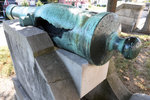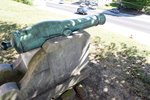Two tarnished cannons guard the entrance to Fort Davidson in Iron County, affording tourists a brief reminder of a battle which was fought there on a September day 157 years ago in the waning hours …
This item is available in full to subscribers.
We have recently launched a new and improved website. To continue reading, you will need to either log into your subscriber account, or purchase a new subscription.
If you are a current print subscriber, you can set up a free website account by clicking here.
Otherwise, click here to view your options for subscribing.
Please log in to continue |
|



Two tarnished cannons guard the entrance to Fort Davidson in Iron County, affording tourists a brief reminder of a battle which was fought there on a September day 157 years ago in the waning hours of the Civil War.
The battle is not remembered as the “Battle of Fort Davidson.” History records the incident — one of a few significant Civil War skirmishes fought in Missouri — as the “Battle of Pilot Knob,” named after a high crag on a mountain that overlooks the fort and battlefield.
Those two tarnished cannons at Fort Davidson have a remote relationship to a small brass cannon — also quite tarnished — which rests in front of the courthouse of Gasconade County in Hermann.
It was the turn of events at the Battle of Pilot Knob which subsequently gave Gasconade County’s little brass cannon its’ sole claim to a small niche in history.
To untangle the little-known facts of this strange twist of historical fate, one must trace the footsteps of Confederate General Sterling Price who, early in 1864, entered Missouri for what was to be a final raid.
The ill-fated expedition ended in failure for the Confederacy, but did bequeath to history one of the last major events of the Civil War in Missouri.
Throughout the Civil War years, Missouri was the scene of some 60 major battles and over 1,100 engagements. Few gained any recognition by scholars and historians.
The Battle of Pilot Knob did… but a minor skirmish in Gasconade County about a week after the Pilot Knob incident has escaped serious attention.
Gen. Price’s Missouri Guard had fought skirmishes and battles throughout the state during the first three years of the “war within a war.” The army had retreated into Arkansas to muster its forces.
Upon the advent of the fourth year of conflict, the rebel general laid plans for a final grand raid into the state with hopes of capturing St. Louis and other important installations, including the Capitol at Jefferson City.
Gen. William S. Rosecrans, in command of the Missouri State Militia and Enrolled State Militia, had been informed of Price’s intentions and fortified the federal garrison at St. Louis with a small number of troops.
Other troops under this command was scattered at several points guarding military depots and railway bridges against guerrillas who were operating all over the state.
When news of the planned assault were confirmed with the advance of Price’s army, federal reinforcements from nearby states were sent to help fortify important points in the path of the raiders.
Price entered southeast Missouri on Sept. 19 and headed for his objective: St. Louis!
He met little or no resistance until he reached Pilot Knob, a high hill overlooking poorly-defended Fort Davidson, at one time the command post of General U.S. Grant.
There Gen. Thomas Ewing defended the little fort with but a single brigade of some 800 men.
The first encounter of Federal and Confederate troops took place on Sept. 26, with the main battle the next day, Sept. 27. It was a bitter battle and Price took command of Pilot Knob and the fort… but not before paying a heavy price with casualties among his 9,000 troops.
Ewing spiked the guns, blew up the powder magazine and by night retreated toward Rolla.
Price then advanced by way of Potosi to the Meramec River. He crossed the river and took up a position 40 miles south of St. Louis. Here he was faced with a decision. The Pilot Knob battle had weakened his army, and he was being pursued by a 6,000-troop Federal regiment under Gen. A.J. Smith, which had ascended the Mississippi River to help Rosecrans.
Fearing to attack St. Louis, Price decided on his secondary objective, Jefferson City, and began a rapid drive toward the Missouri River and then westward toward the state capitol.
Gasconade County lay in his path!
Most of the county’s young men had joined 10 companies of home guards. Six were from the central and southern parts of the county. When united with Gen. Nathan Lyon’s Fourth Missouri Reserve Corps, these regiments had charge of protecting railroad bridges between St. Louis and Jefferson City.
When Price began his drive into Missouri, these troops were sent to Rolla and Jefferson City as reinforcements.
Hermann, the largest settlement in the county, was left with few defenders. The German town lay directly in the path of Price’s army as it advanced toward Jefferson City.
The rebel general entered Gasconade County on Oct. 2 from Franklin County.
Hermann’s few defenders had but one artillery piece — a small brass cannon — and it could not be expected to hold off any army… not for long.
The defenders then hatched a plot which, they hoped, would cause Price to detour around the settlement. Hiding the women and children in caves in the vicinity and on Graf’s Island in the Missouri River, they set up their brave scheme.
As the Confederate force came into view around a bluff east of the town, the little cannon belched forth its first volley which sent theraiders retreating, only to advance again in another direction.
By the time of the second approach, the defenders had moved the cannon to another position, and again it sent forth another volley.
According to stories passed down through generations, the cannon was moved back and forth, from position to position, causing Price to suppose that the settlement had a large complement of artillery pieces. He continued his approach toward the town, but with caution.
The ruse had worked for a while, but now the few defenders knew it was foolish to try and hold out. They spiked their little cannon, and threw it into the Missouri River.
Price then continued his push toward Jefferson City. As he was being delayed at Hermann, a regiment of mounted men — chiefly Missouri State Militia-men under Gen. McNeil — had made a forced march from Rolla and reached the Capitol before Price arrived. They bolstered the capitol defenders, and Gen. Price and his confederate raiders were defeated.
Price’s army did fight in several other major battles before the war’s end the next year, 1865.
When the story of the brass cannon and the ruse became known, the little artillery piece was recovered from the river and used on holiday celebrations and festive occasions.
On one Fourth of July, so the story goes, an unusually large powder charge caused it to split.
The cannon was later mounted on a marble pedestal in front of the Gasconade County Courthouse and has since occupied an unmarked and unheralded position.
It’s open volley on that day in 1864 could hardly be remembered as a shot “heard ‘round the world’.” In fact, the echo died in the same hills where it was born.
The little cannon — which single-handedly held off an army for a short while — is more than a symbol of the bravery and courage which Missourians were able to muster in the face of what seemed to be over-whelming odds.
It is Gasconade County’s only memento of the Civil War… its’ only brush with fame.
The lonely little cannon and a handful of men almost perpetrated what could have been one of the greatest ruses of military history had it caused Gen. Price to retreat.
And what would have happened had the diversion not taken place Gen. Price reached the state capitol before those reinforcements from Rolla? It could have completely changed the war in Missouri and bolster the Confederate cause!
This, of course, is conjecture.
Only the little cannon knows for sure… and it hasn’t spoken in many, many years.
(NOTE: this story was originally published in the Gasconade County Republican on Sept. 23, 1981.)